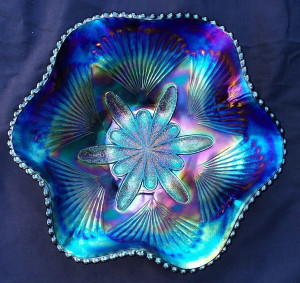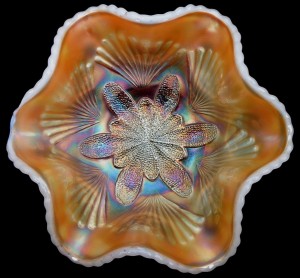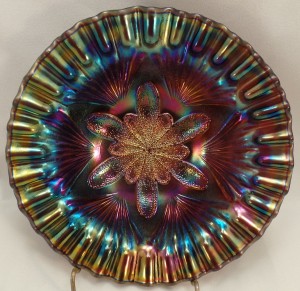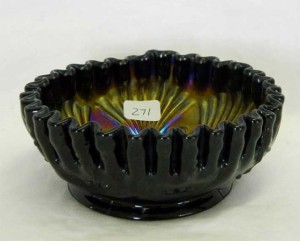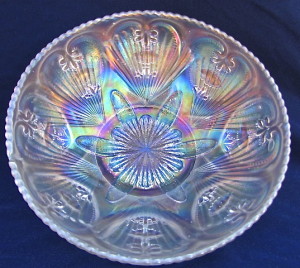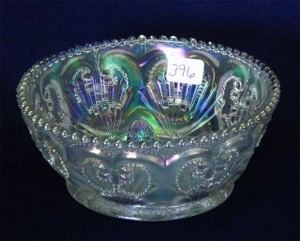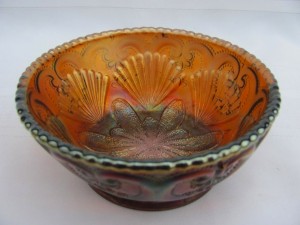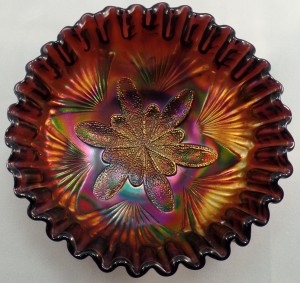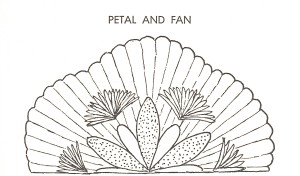By Dr. Larry Keig
The stylized Petal and Fan pattern, attractive but unremarkable, is unfortunately sometimes dismissed as humdrum. That may be because it is customarily associated with a small number of shapes in a narrow range of colors. While it is undeniable the color spectrum is limited, more shapes are available than initially meet the eye.
The principal design elements of the interior are: (a) a center blossom with alternating long and short petals, all of them stippled, and (b) fans set between the long petals, their bases coming to within about three-eighth of an inch from the short and the tips of their folds extending outward toward the edge.
The exquisitely cast exterior is Jeweled Heart, a pattern also found on the reverse of Dugan’s collar-based Cherries, Farmyard, Smooth Rays, and once in a while collar-based Ski Star, and on water sets. Its key features are: (a) highly embossed outlines of eight hearts, (b) “jewels” that dangle like a glittering pendant from the point at which the ventricles converge and rise like tied down, helium inflated balloons from the tuck at the base of the heart, and (c) tiny beads which follow the interior contour of the heart and jewels. The upper edge is serrated.
Two molds are known to have been employed in producing the small bowls. One has a 24-rayed star embedded on the undersurface of the base. The other has an unpatterned base. Yet another mold was, of course, used to make the large items, where all have a 38-rayed star cut into the underside of the base.
Based on advertising placed in trade publications of the day and the colors available, Petal and Fan appears to be exclusively Dugan. There is little indication to suggest it was made after Diamond assumed ownership of the company in July 1913.
Conventional Shapes
The most available shapes are six- and eight-ruffled bowls, small plates with a tightly-crimped edge, and, in lesser quantities, small crimped-edge bowls. Ruffled bowls are seen regularly in both large and small sizes, crimped bowls and plates only in the small size.
The large ruffled bowls range from ten to eleven inches in diameter and stand from three to three and one-half inches tall. The eight-ruffled are deeper than the six-. The eight-ruffled are, in my view, more attractive than the six-, because all the heart medallions are situated within the folds of ruffles.
The most available color is the peach opal. The next most often seen is the amethyst, typically a relatively dark purple. The white are seen less often. By far the hardest to find are the marigold, in all likelihood because marigold was a color made in comparatively small amounts by Dugan, production exploding only after the firm’s 1913 restructuring. A honey amber is reported as having sold for $750 in 2002. The amethyst with brilliant iridescence is normally considered the most desirable.
Illustrated is a showy large ruffled bowl in purple from Kevin and April Clark’s collection. It measures ten inches in diameter and stands three and one-half inches tall. The Clarks also own large ruffled bowls in peach opal, white, and marigold.
The small bowls are also found six- and eight-ruffled. Peach opal and amethyst are the most often seen. The white are harder to locate. The small marigold are really difficult to track down, seen even less often than the large.
The six-ruffled small bowl illustrated, from Kate and Bill LaVelle’s collection, has a 24-rayed star pressed into the bottom of the base. It has pretty surface color, opalescence, and iridescence. Not many peach opal Petal and Fan bowls are as attractive as this one.
Dugan also marketed berry sets. In recent years, sets—a master and six serving-size bowls, all ruffled—have sold in peach opal and white, the former easier to find than the latter. As the raconteur Tom Burns has on occasion noted, you know a set has been cobbled together if all items are well matched in color. That’s because packers were unselective when sets were crated and because quality control in the classic carnival era was nothing like it is today. Regardless, I’d bet a contemporary collector would pay more for a well-matched set than for one with items of disparate base or surface color and iridescence.
Tightly-crimped plates are easier to locate than crimped bowls, but the plates are generally considered more desirable. The plates measure from six and one-half to seven inches in diameter, size dependent on the degree of flatness or uprightness of the crimps.
Crimped-edge plates have been reported only in peach opal and amethyst. The beautifully iridized amethyst illustrated is six and one-half inches in diameter and one and one-eighth inches tall. It belongs to Don and Kris Dorais. They bought it from Moe Myers, a well-known Dugan and vase collector and longstanding NECGA member, in 2005.
I am surprised no small plates have surfaced in white. It is also remotely possible a marigold may be out there somewhere. I have wondered if flat (non-crimped) plates exist.
Bowls with tightly-crimped edges, like plates, have been reported only in peach opal and amethyst, in about equal proportions. Some are quite shallow, others deeper. The attractive deep crimped illustrated had been owned by Joan and Tom Steskal until it sold at the 2015 ICGA convention auction in St. Louis.
Seldom Seen Shapes
Several out-of-the-ordinary shapes have been confirmed. Some are known to have been made from the large mold, others from the two small molds.
Large Bowls. Large ice-cream-shape bowls are dimensionally substantial and visually impressive. Measuring about ten inches in diameter, they have been confirmed in white and marigold, the former seen more often. They may also be available in peach opal and amethyst.
The illustrated white ICS bowl had been in Bill and Carole Richards’s collection before it sold at a Burns auction in May 2014. Its top diameter is nine and three-fourth inches, and it is three and one-half inches tall. It would look nice at Christmas heaped high with spherical ornaments in assorted vivid colors or holiday-wrapped Hershey Kisses.
A large square-ruffled bowl is known. As far as I have been able to determine, it has been confirmed only in amethyst. The one of which I am aware sold at the 2004 Lincoln Land convention auction conducted by David and Amy Ayres.
Someone out there owns an amethyst rose bowl. Until it changed hands at the 1998 ICGA convention auction conducted by the Seecks, it had been in John and Lucile Britt’s collection. It brought $235, a reasonable price for what may be a one-of-a-kind. I presume it was produced from the large mold but am not certain. It should display the striking Jeweled Heart secondary pattern to its best advantage.
Small Bowls. Small bowls are occasionally found in a banana-shape and in a non-crimped deep round sauce. The banana-shape, with two sides folded, has been reported only in peach opal. While scarce, it is not as hard to find as once believed.
The peach opal banana-shape bowl is also available as part of a two-piece basket. In baskets, the bowl is set in an ornate metal frame. One sold at the ACGA convention auction, conducted by the Burns Auction Service, in 1998. Another was offered for sale by Tom and Sharon Mordini at the 2000 ICGA convention in Des Moines.
Other Dugan bowls set in metal frames—for example, large collar-based Ski Star, mid-size Daisy Dear, and small deeply ruffled Fishscale and Beads and ruffled and tightly-crimped banana-shape Smooth Rays/Jeweled Heart—also occasionally surface. Frames for baskets or condiment containers of this type were outsourced by the firm, not in-house produced. These baskets were marketed in small quantities, probably from late 1910 through 1911.
The non-crimped deep round sauces measure four and three-fourth inches in diameter and stand just over two inches tall. I believe they are the proofs from which the other small bowls and plates were configured. Two slightly different versions are known. One has a ledge around the top interior. This ledge resembles ledges that hold in place the tops to covered sugars and creamers. The illustrated white sold at Seeck Auctions in Mason City, Iowa, in November 2013. The undersurface of its base is unpatterned.
The other deep sauce is absent the ledge, and it has a star embedded in the bottom of the base. The illustrated example was sold by the Burns Auction Service in August 2015. I believe its base color is amethyst, although it looks “sorta horehound” as Tom described it in the listing. The light base color is atypical of a piece presumably made by Dugan. I suspect this is the same bowl pictured in the Edwards-Carwile Encyclopedia (7th ed., p. 406) as the iridescence on the two looks identical.
Also illustrated is what I am inclined to call a tightly-crimped ice-cream-shape bowl. It is five and one-half inches in diameter and one and three-fourth inches high. In size, it is similar to Northwood’s Peacock and Urn small ICS, though the edge treatments are different: the Northwood scalloped, the Dugan crimped. Until Don and Kris Dorais purchased this interesting shape in 2000, it had belonged to Paul Berube, a long-time NECGA member also active in other clubs.
It is sometimes difficult to categorize bowl shapes. What one collector may, for example, call deep round, another may describe as ICS. I’ve grappled with distinctions like this for years, without arriving at an entirely satisfactory conclusion. But for Dugan small bowls, I currently apply two “rules,” both of which must be met: a “two-inch rule” for height and a “five-inch rule” for top diameter. To qualify as a “deep sauce,” the bowl must be at least two inches tall and less than five inches in diameter. A bowl that is less than two inches tall and five or more inches in diameter is something else.
Hartung’s Petal and Fan
Marion Hartung’s Petal and Fan line drawing (First Book of Carnival Glass, p. 41) differs from the above description. In Hartung’s (see drawing), the long petals are stippled, the short non-stippled. On every Petal and Fan I have seen or heard of, all petals are stippled.
According to Hartung, the petals and fans are superimposed over a background of “smooth even ribs.” I have yet to see ribs (or smooth rays) of this type and suspect she was conflating ribs with the folds of fans.
While it’s possible the Hartung pattern exists, I have doubts. My guess is that she got sidetracked while sketching and forgot to stipple the short petals.
If examples of the Hartung are available, they are exceedingly rare. And if they exist, the Petal and Fan we regularly see is a Variant.
This situation reminds me of discussions of differences between Garden Path and Garden Path Variant. Hartung provides line drawings for both although, as far as I know, no Garden Path bowl or plate has been confirmed. I suspect, in this case, either she got waylaid while drawing Garden Path, forgetting to add the “palm trees” and “winged hearts” around the otter edge, or (more likely) those elements were cloaked by the ruffles on the bowl from which she sketched. But it’s possible a Garden Path will sometime surface so I keep looking, as I have for more years than I care to remember.
I continue to search for the Hartung Petal and Fan, too.
Acknowledgements
I am grateful for photos provided by the carnival community: Tom Burns, Kevin and April Clark, Don and Kris Dorais, Kate and Bill LaVelle, and Jan and Jim Seeck. Thanks also to a cadre of conferees who, along the way, fact-checked, verified or refuted, and supplied information: Neal Becker, Carl Booker, Barb Chamberlain, and Dick Thorne.

